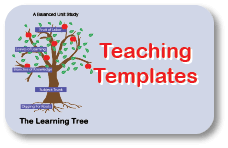Beaufort Scale
The Beaufort Scale MatchCard provides students with experience identifying wind strength.
Free Download Below
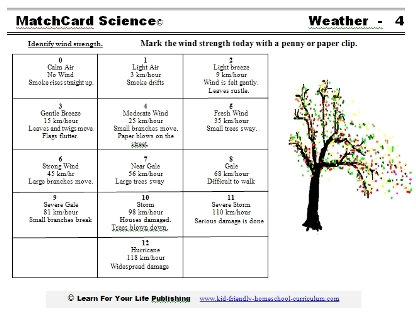
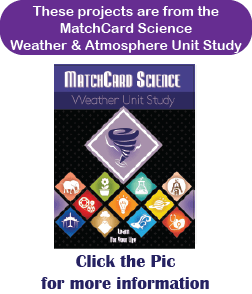
Wind Strength
Objective: Identify wind strength.Background: In 1805 Admiral Sir Francis Beaufort of the British Navy developed this scale of wind strength. It is based on observation, rather than scientifically measured strength. It is the most common wind scale used today.
Download and Use the Beaufort Scale Chart
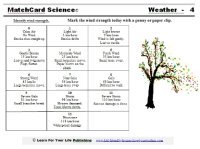

Click image to go to download.
This is MatchCard #4 of the Weather Unit Study. Find more information on MatchCard Science below.
Go Outside
Start outside. Have students close their eyes, and detect any movement of the air. Do they feel it? Hear it? Any change in smells?Then have them open their eyes. What do they see that indicates the wind is blowing. Describe as many details as possible.
Learning Activities
Let's Guess
- Beaufort
Ask: On a scale of 0 to 12, with "0" no wind; and "12" a severe hurricane, what number would you give today's wind?
- Miles Per Hour
Ask: How many miles per hour do you think the wind is blowing?
The first day, this will be a guess in the dark. Each day the students do this, they will become more proficient in their estimations.
Look At the Beaufort Scale
Now students will go inside (or stay outside), read the description on the MatchCard, and place a token on the box that best describes the effect of today's wind.How close were their guesses?
Here is the scale:
0
Calm Air
No Wind
Smoke rises straight up.
1
Light Air
3 km/hour
Smoke drifts
2
Light breeze
9 km/hour
Wind is felt gently.
Leaves rustle.
3
Gentle Breeze
15 km/hour
Leaves and twigs move.
Flags flutter.
4
Moderate Wind
25 km/hour
Small branches move.
Paper blows on the street.
5
Fresh Wind
35 km/hour
Small trees sway.
6
Strong Wind
45 km/hr
Large branches move.
7
Near Gale
56 km/hour
Large trees sway
8
Gale
68 km/hour
Difficult to walk
9
Severe Gale
81 km/hour
Small branches break
10
Storm
98 km/hour
Houses damaged
Trees blown down
11
Severe Storm
110 km/hour
Serious damage is done
12
Hurricane
118 km/hour
Widespread damage
Check the Weather Report
Now check your local weather report.Do they agree with your findings? Remember, that the weather report may be at a different time of the day (and wind speeds can change dramatically very quickly.) Brainstorm: What else could cause differences in the weather report?
- How close the weather station is to your area
- Hills, trees, valleys
- Distance from the ground to where it is measured
Make A Chart of Your Wind Estimate
Develop a ten day chart to record your guesses regarding wind speed before looking at the MatchCard. After making your estimate, check the MatchCard. Then check the weather report.

Use an Anemometer
Wind speed is estimated with an instrument called an anemometer.You can make a simple anemometer using five bathroom sized paper cups, two straws, and a pencil. This will not be an acurate indicator of wind speed, but if your lucky, it will spin.
On the other hand, you can buy an actual anemometer and calculate the speed of the wind by counting the revolutions per minute. A commercial anemometer will give you the conversion factor to convert revolutions per minute to miles per hour. These can cost $10 to $25. Of course, in a gale I would not expect you to stand outside and count 500 revolutions per minute.
For more money, you can buy a more accurate wind indicator that COULD be used for high speeds. My recommendation would generally be to take cover and let the weather man do those calucations.
Repeat
One of the strengths of MatchCard science is the built in repetition. It takes only a few minutes to do this activity. It will not only increase their proficiency with the Beaufort Scale, but will also sharpen their observation skills.You can have the student do this activity every day for seven days, or for a whole month.
We recommend doing it daily for the first few weeks, then weekly the rest of the year. That will give experience in different weather conditions as the seasons change.
MatchCard Science
How To Use MatchCards

Download the FREE MatchCard Science Instructor's Guide and see how MatchCards can make building their science knowledge base fun.
Weather Unit Study
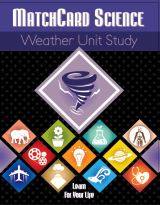
Nine different weather lessons can be presented in this 4 week study.
Download the entire Weather Unit Study.
12 Science Unit Studies

Chemistry is only one of twelve complete unit studies for kids in 3rd to 8th grade.
Comprehensive objectives, hands-on projects, suggested science fair experiments, and the fun game-like MatchCards keep them interested in learning science. See all twelve MatchCard Science Unit Studies.
About Our Site
Hands-On Learning




